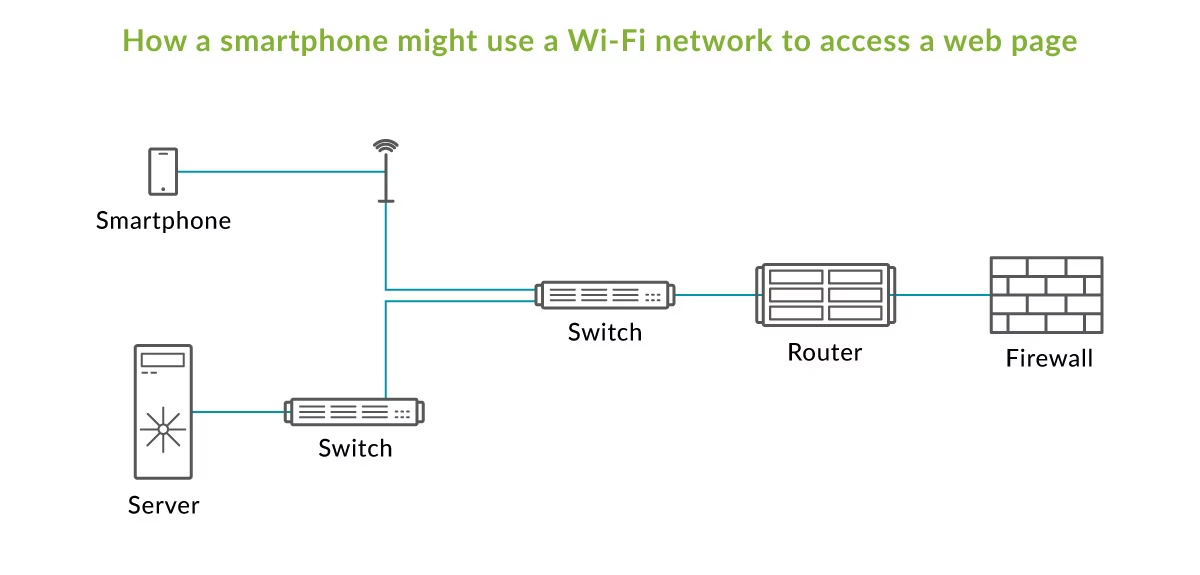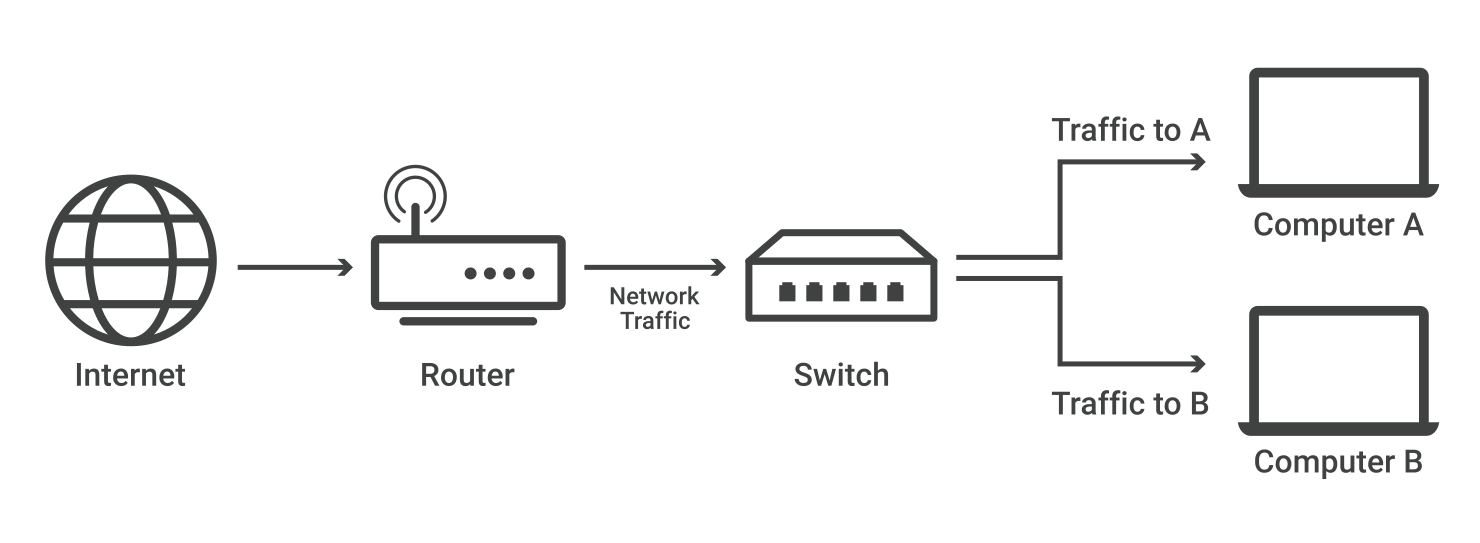Switches
Switches are essential networking devices that connect multiple devices within a network and enable them to communicate with one another.
 Ruth Victor
Ruth Victor
A network switch is a device that enables two or more IT devices, like computers, to communicate with each other, forming a communications network. By connecting multiple IT devices, various resources such as computing power, printing, servers, file storage, and internet access can be shared across the network. Devices in a network communicate by exchanging data packets. Basic switches facilitate the transfer of packets between devices, while more complex tasks, like determining if a packet should reach its intended destination, are typically handled by other network devices. Switches can exist as standalone appliances or as components within other equipment like network routers and wireless access points (APs), which process data packets. Basic switching technology has been a cornerstone of IT networks for decades, serving as a fundamental element in modern networks, including the Internet.
A network switch facilitates communication among users, applications, and equipment within a
network, enabling resource sharing. Basic switches connect devices within a single
local-area network (LAN), while advanced switches extend connectivity across multiple LANs
and may include basic security features.
Advanced switches, though capable of more than simple LAN interconnection, primarily serve
to connect devices in IT networks. They can create virtual networks, allowing network
administrators to isolate groups of systems for security purposes. Virtual network types
like virtual private networks (VPNs), virtual LANs (VLANs), and Ethernet VPN-virtual
eXtensible LANs (EVPN-VXLANs) are commonly used in midsize and large networks, with
EVPN-VXLAN becoming increasingly prevalent in modern enterprise setups.
Network switches vary in speed, capabilities, and sizes, supporting anywhere from a few to
thousands of devices. Multiple switches can be interconnected, forming different network
topologies. A modern "spine-leaf" topology, for example, utilizes high-speed switches with
high port density to connect tens of thousands of devices in a single network. In spine-leaf
data center networks, leaf switches aggregate traffic from servers and connect to spine
switches, which interconnect all leaf switches. Such networks often employ EVPN-VXLAN for
segmentation, making them suitable for multitenant data centers, government, and large
enterprise use.
A network switch facilitates inter-device communication by adhering to standard communication protocols established and maintained by international standards organizations like the IEEE and the IETF. Devices connect to a network using radio (Wi-Fi), electrical (RJ-45 Ethernet), or light-based optics (fiber-optic cabling). Each connection method employs a distinct physical interconnection—RF spectrum, copper cabling, or fiber-optic cabling—over which devices communicate by exchanging streams of 1s and 0s. Network standards ensure these streams are interpreted into packets, consisting of headers and payloads. Packet headers contain source and destination addresses, while payloads carry the exchanged data. Each device on a network has one or more addresses to which packets can be directed. Packets exchanged between addresses form "data flows," akin to conversations among networked devices. Switches read addresses from packet headers and forward packets toward their destinations based on lookup tables (LUTs). LUTs maintain lists of addresses reachable via specific switch ports. Additionally, routers can be configured with "routes," directing switches to send packets with certain destinations to intermediary devices. For instance, a smartphone accessing a web page via a home Wi-Fi network connects to an access point (AP), which contains a built-in RJ-45/Ethernet switch linked to an Internet router.

Devices such as smartphones access web servers and other remote resources through a series of interconnected switches and routers communicating with each other, hop by hop, from source to destination and back. This communication occurs using standard communications protocols and addressing schemes.
As a packet of data leaves the smartphone's radio, it's received by the access point (AP). Upon inspection, if the AP doesn't recognize the destination address in the packet header, it forwards a copy of the packet to the Internet router as per its configuration. The data packet then embarks on its journey across the Internet, traversing routers and an unknown number of switches in between until it reaches the web server. Upon receiving the packet, the web server responds by sending data packets back along the same path, eventually reaching the original source Internet router, the AP-embedded switch, and finally, the smartphone. This packet exchange establishes a data flow between the smartphone and the web server, facilitated by numerous hardware devices and associated software. Throughout this process, adherence to long-standing standards ensures seamless communication between the source and destination.
Understanding the varieties of network switches is essential for finding the suitable solution to adapt to your evolving business needs. Consider different switch categories and their specific advantages as you explore available options.
Modular switches offer the flexibility to add expansion modules as required, accommodating changes in network requirements. These modules, tailored to specific applications, encompass functionalities such as firewalls, wireless connectivity, or network analysis. They may also support additional interfaces, power supplies, or cooling fans. While providing maximum flexibility, this type of switch typically comes at a higher cost.
Fixed-configuration switches come with a predetermined number of ports and usually cannot be expanded, resulting in a lower overall cost. This category encompasses unmanaged switches, smart switches, and managed switches.
Unmanaged switches are primarily utilized for fundamental connectivity purposes. They are designed to be plug-and-play, requiring no configuration. Unmanaged switches are best suited for scenarios where basic switching and connectivity suffice, such as in home networks or in environments requiring only a few ports, like desks, labs, or conference rooms. While some unmanaged switches may offer limited advanced features, their core characteristic is their inability to be modified or managed, as implied by their name.
Smart switches provide partial management functionalities, including segmentation, quality of service, and security features, making them a cost-effective option compared to modular switches. However, they are not as scalable as managed switches. Smart switches are commonly deployed at the network edge in large networks, as infrastructure for smaller networks, or in networks with low complexity, while managed switches are typically used in the core.
Of all fixed-configuration switches, managed switches are engineered to offer the most extensive array of features, ensuring optimal application experience, top-notch security, precise network control and management, and maximum scalability. Consequently, managed switches are typically employed as aggregation/access switches in expansive networks or as core switches in smaller networks. As the priciest option among fixed-configuration switches, managed switches are prevalent in organizations with sizable or expanding networks.

Switches are available in various throughputs or speeds, measured in megabits per second (Mbps). For example, fixed-configuration switches can offer Fast Ethernet (10/100 Mbps), Gigabit Ethernet (10/100/1000 Mbps), Ten Gigabit (10/100/1000/10000 Mbps), and even 40/100 Gbps (gigabits per second) speeds. The switch speed you select depends on your throughput requirements. If you regularly transfer large data files, a Gigabit Ethernet switch is advisable.
Power over Ethernet (PoE) allows you to power devices like IP phones, surveillance cameras, or wireless access points using the same cable that transmits data. This enables you to place endpoints in locations that are typically hard to reach. However, switches with PoE are more expensive. When evaluating your options, consider the devices you need to connect to determine if PoE is necessary.
As your business and network grow, you'll likely need to support an increasing number of devices, necessitating the investment in additional switches. A standalone switch, as the name suggests, is managed and configured individually with limited capacity. Troubleshooting issues are also specific to each switch.
In contrast, stackable switches can be connected to enhance the capacity and availability of your network. Instead of configuring, managing, and troubleshooting each switch individually, you can treat the entire "stack" as a single unit. This ensures that if any part of the stack fails, the stack will reroute around the failure, maintaining network operation.
Routers select paths for data packets to traverse networks and reach their destinations. They achieve this by connecting to different networks and forwarding data between them, encompassing local area networks (LANs), wide area networks (WANs), and autonomous systems, which constitute the Internet. In practice, this means routers are essential for an Internet connection, whereas switches are used primarily for interconnecting devices. Homes and small offices need routers for Internet access but typically do not require network switches unless they need numerous Ethernet ports. Conversely, large offices, networks, and data centers with dozens or hundreds of computers usually require switches.
*Ethernet is a layer 2 protocol for sending data between devices. Unlike WiFi, Ethernet requires a physical connection via an Ethernet cable.
Network switches can operate at either OSI layer 2 (the data link layer) or layer 3 (the network layer). Layer 2 switches forward data based on the destination MAC address, while layer 3 switches forward data based on the destination IP address. Some switches are capable of handling both functions. However, most switches are layer 2 switches. They typically connect to devices in their networks using Ethernet cables, which are physical cables that plug into devices via Ethernet ports.